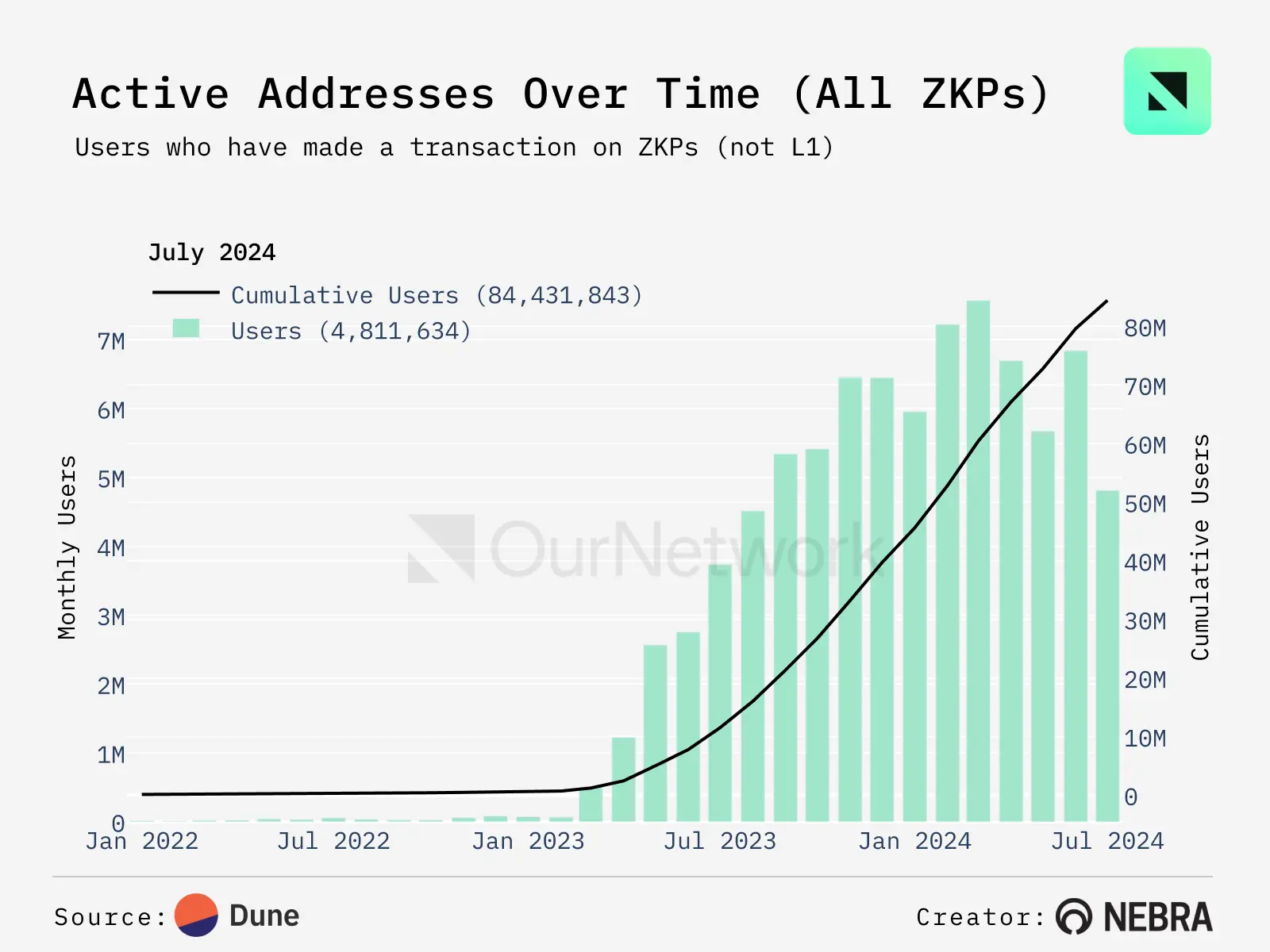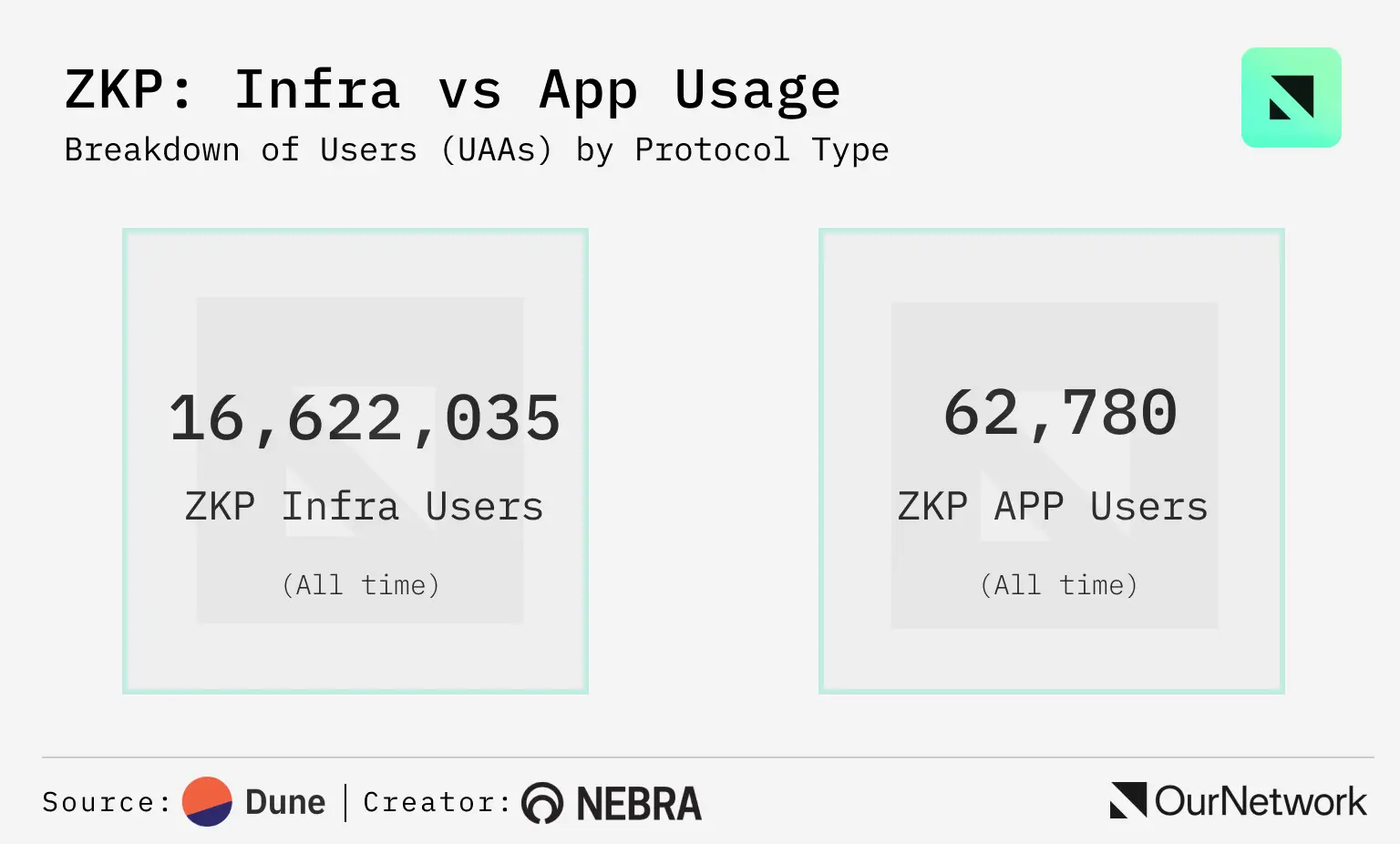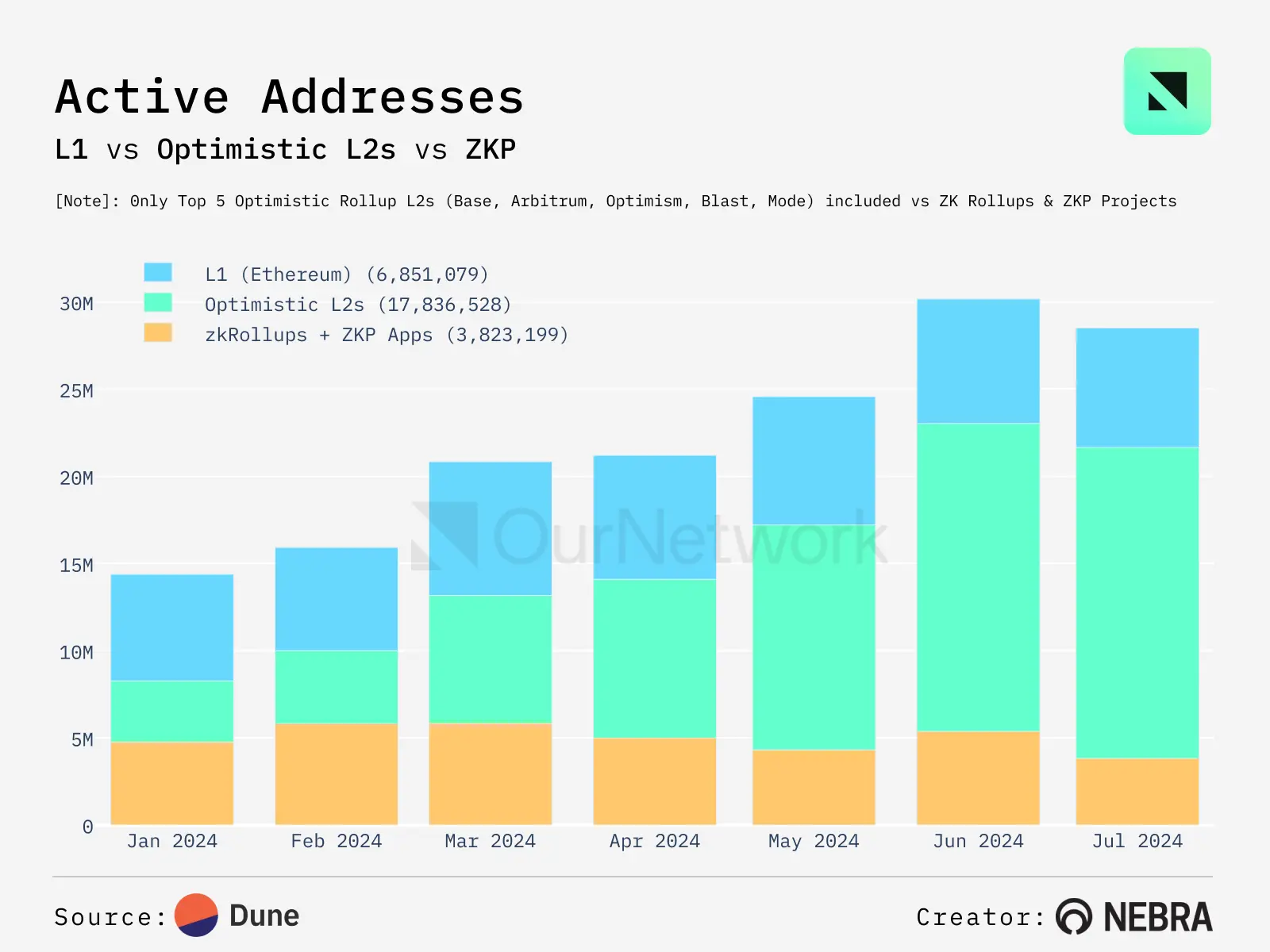Data Reading ZK: L2 spending on ZKP has exceeded 60 million dollars, zkRollup is gradually rising
Original Title: “Zoomed-in on ZK Proofs”
Author: OurNetwork
Compiled by: Shenchao TechFlow

In this issue, we will focus on Zero-Knowledge Proofs (ZKPs) — one of the most important yet least understood technological breakthroughs in our industry. We will explore the growth of zero-knowledge, its adoption, network health, and the competitive dynamics at both the application and infrastructure levels.
Why This Matters:
For crypto applications to achieve true mainstream adoption globally, the blockchains they rely on must become more scalable and efficient. For Ethereum, the largest Layer 1 blockchain, and its community, this has prompted a strategy of actively embracing Layer 2 scaling solutions. L2s like Optimism, Arbitrum, and Base are the first wave of innovations in this space, now serving as major platforms for crypto users and applications, locking in billions of dollars in value and boasting millions of active addresses.
At the same time, Zero-Knowledge Proofs (ZKPs) represent another significant breakthrough in scaling solutions, theoretically outperforming existing infrastructure and supporting a variety of new applications. Although this field is just getting started, we believe its rapid progress in a short time warrants our attention.
While it may still be early, on-chain data supports the argument — cryptocurrency is undergoing a significant shift towards Zero-Knowledge Proofs (ZKPs), starting with ZKP applications and then ZKP-supported infrastructure, such as Rollups. I would like to especially thank the NEBRA and OurNetwork teams, as well as core data contributors Jackie (Dune) and Brandyn (OurNetwork); without their support, none of this would be possible. We now present this shift through data.

① ZKP: Sector Health
Total spending on Zero-Knowledge Proofs (ZKPs) by Layer 2 solutions has exceeded $60 million.
- The total settlement fees (TSF) paid by ZKP projects to Ethereum L1 have surpassed $60.4 million, showing significant adoption over time. In December 2023, TSF peaked at $15 million. In the past 30 days, the TSF for ZKP verification on Ethereum L1 was only $150,000, reflecting progress in optimizing costs in this area.

- In 2023 and 2024, the number of active addresses using ZKPs has continued to rise, peaking at 7.6 million in March this year. Although the number of active addresses dropped to 4.8 million in July 2024, marking an annual low, the average number of active addresses for the year was 6.4 million, more than doubling the monthly average of 3.2 million active addresses in 2023, despite the overall market being in a summer slump.

- Last month, over 1.5 million proofs were accumulated, but the number of ZK proofs settled on L1 blocks in 2024 has decreased, with the number of proofs settled on L1 reaching a peak of 189,280 in December 2023.

- This trend is primarily due to a slight decline in demand (active users), but more importantly, technological advancements, as zkRollups have adopted new technologies like proof aggregation to reduce the number of proofs and TSF.
② ZKP: Project Trends
Linea generated 23.2 million ZKP transactions from 5.5 million users.
- In terms of ZKP user adoption, Linea is becoming a "successful" chain. In the past 30 days, this L2 led with 1.77 million unique active addresses, followed by zkSync with 1.3 million and Scroll with 950,000.

- In December 2023, Linea's L1 spending on ZKPs surged to $12.8 million, accounting for nearly 85% of all project spending on ZKPs that month, still a historical high for payment fees, largely thanks to Linea's Voyage XP program. Recently, in 2024, Scroll has begun to dominate payments to L1 in TSF, with further cost reductions expected in the planned upgrade on August 21.

③ ZKP: Infrastructure vs. Applications
The number of infrastructures using ZKP is over 250 times that of applications.
- To date, 16.6 million addresses have triggered ZKP transactions through infrastructure, particularly zkRollups, while only 62,780 addresses have triggered ZKP transactions through applications.

- This stark contrast has several key reasons. First, in August 2022, OFAC sanctioned Tornado Cash, a key application using ZKP for privacy. This made it illegal for U.S. citizens to use Tornado Cash, leading to a decrease in ZKP usage in applications. Second, the cost of each ZKP transaction on the infrastructure layer is significantly lower than that on the application layer — Linea's 30-day average transaction cost is $0.00034. Although the average transaction cost for the most expensive ZKP infrastructure, Polygon zkEVM, is $0.03, it is still far lower than the transaction costs of top ZKP applications.

- With the dust settling from OFAC sanctions, the usage of ZKP applications has seen a revival. Tornado Cash remains a relatively inexpensive ZK application in terms of transaction costs, averaging $1.00 over 30 days. Although this is not a fully comparable comparison due to higher L1 fees, the cost of Tornado transactions is still about 33 times higher than that of Polygon zkEVM and about 3,300 times higher than that of Linea.

④ ZKP: Macro Trends
The top five Optimistic Rollups still dominate zkRollups in terms of active addresses, with a ratio of 4; however, zkRollups are nearing a balance with the number of active addresses on Ethereum L1 this year.
- The active addresses of the top five Optimistic Rollups have grown this year, increasing from 3.8 million in January 2024 (actually lower than zkRollups' 4.8 million) to over 17.8 million. While many zkRollup chains are yet to launch, it is noteworthy that these solutions have attracted over half of Ethereum L1's addresses in each complete month — as of July, active addresses on zkRollups still accounted for 13% of the market share of Ethereum L1 and the top five Optimistic Rollups.

- Last month, zkRollup Linea ranked third among L2s with 1.8 million active addresses. Base leads all L2s with 11.5 million active addresses, followed closely by Arbitrum with 5.8 million.

- As L2s adopt more efficient ZKP-related technologies, the proportion of gas fees attributed to ZKP contract calls has actually dropped to 0.14% of the 30-day rolling average. This is about 100 times lower than the record peak, which occurred in December 2023, when ZKP transactions accounted for over 14% of Ethereum's total gas fees on two occasions.


ZK Proofs: The Proof Singularity Future Brought by NEBRA
The key technology for expanding Zero-Knowledge Proof (ZKP) block space is proof aggregation, which consolidates multiple proofs from different sources into a single recursive proof to validate the validity of these proofs (i.e., the aggregated proof).

Nebra
Proof aggregation protocols like NEBRA UPA significantly increase bandwidth and reduce the costs of on-chain zero-knowledge proofs. For example, in the current version of NEBRA UPA, the verification cost of Groth16 proofs has been reduced from 300,000 gas to 18,000 gas, a reduction of over 15 times. This is similar to how data availability protocols (such as 4844, Celestia, EigenDA, and Avail) reduce data availability costs.
Moreover, proof aggregation can achieve what Vitalik Buterin calls the "proof singularity," where each block contains only one aggregated proof. Proof aggregation is not only used to reduce the costs of on-chain ZKP verification but also enables native interoperability and shared settlement between zkRollups.

The launch of UPA on the Ethereum mainnet by NEBRA and its future Rollup operating system marks a significant breakthrough for the entire ZK field. With the arrival of the proof singularity, the future of ZK and blockchain looks brighter. Imagine if proofs could be aggregated, Ethereum would save over $39 million in costs!


Concepts:
Zero-Knowledge Proofs (ZKPs) allow for the verification of arbitrary computations using small cryptographic proofs while providing privacy protection. Applications and infrastructure typically use zero-knowledge proofs in two ways:
Privacy Protection
Verifiable Computation and Scalability
Nebra

In these cases, zero-knowledge proofs are generated by combining user-specific data with publicly available data on the chain. Subsequently, these proofs are verified on-chain to execute certain subsequent business logic.
Privacy Protection Applications:
In terms of data flow, when zero-knowledge proofs are used for privacy protection applications, the generation of proofs needs to occur on the client side to avoid leaking sensitive user information (such as private keys). In these applications, the user-controlled client (whether a browser or an application running on a mobile device) directly submits the proof to the blockchain.
Examples:
ZK-based identity solutions, such as Worldcoin
Privacy-preserving financial applications, like tornado.cash and railgun
Scaling Solutions:
When zero-knowledge proofs are used for scaling, the generation of proofs typically does not require sensitive user data. Therefore, proof generation can be delegated to more powerful servers or public clouds. Some scaling solutions utilize GPU acceleration to improve the throughput and latency of proof generation.
Examples:
zkRollups, such as zkSync, Polygon zkEVM, Scroll, Starkware, and Linea
zkCoprocessors, such as Succinct, RISC Zero, Axiom, Brevis, and Lagrange
Methodology:
Through this dashboard, we are measuring three key metrics:
Total Settlement Fees (TSF): Refers to the total amount of ETH paid by users or scaling solutions to verify zero-knowledge proofs on-chain. These fees can typically be broken down into cryptographic-related precompiles that call the EVM (which will be detailed later).
On-chain Transaction Count: The number of transactions verifying zero-knowledge proofs.
Number of Active Users: The number of users utilizing ZK proofs.
How Do We Measure?
We implemented queries on Ethereum's Dune index data to obtain gas expenditures for ZKP verification. By identifying the correct contracts and transaction calling methods, we determined the relevant internal calls (see the annotated data methodology in this section). These expenditures primarily come from calling the following precompiles:










